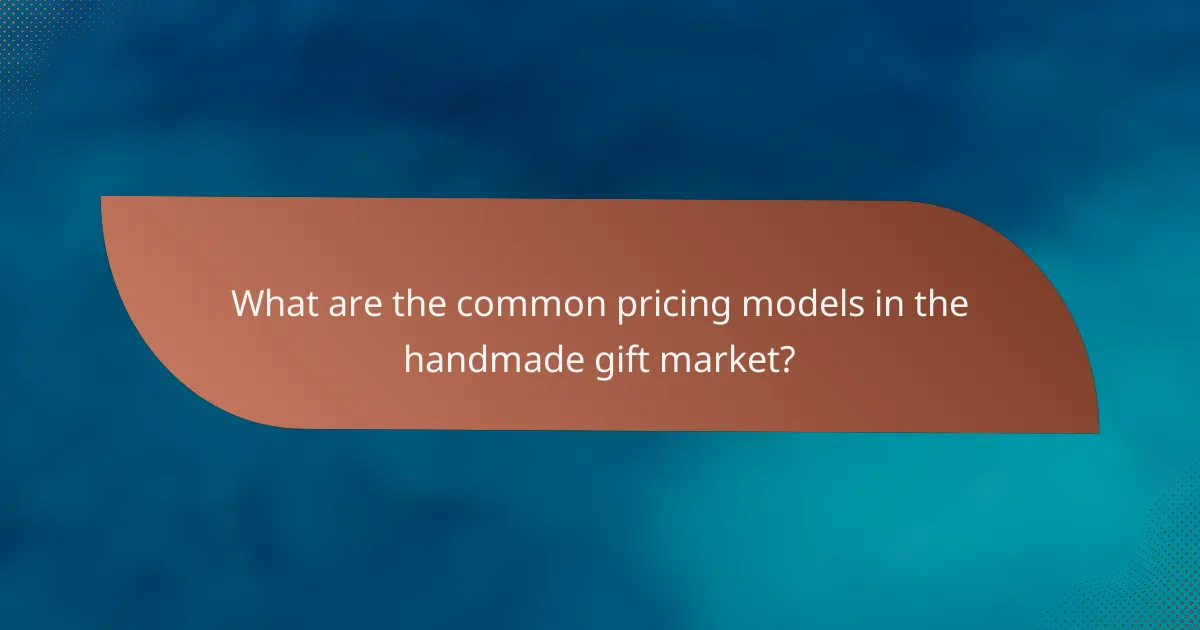In the handmade gift market, understanding pricing models is essential for artisans to effectively position their products. Common strategies such as cost-plus, value-based, and dynamic pricing allow sellers to set prices that reflect both their costs and the perceived value of their creations. By considering factors like material costs, market demand, and customer demographics, artisans can establish competitive prices that resonate with their target audience.

What are the common pricing models in the handmade gift market?
Common pricing models in the handmade gift market include cost-plus, value-based, dynamic, tiered, and freemium pricing. Each model offers different strategies for setting prices based on costs, perceived value, market demand, and customer segmentation.
Cost-plus pricing
Cost-plus pricing involves calculating the total cost of producing a handmade gift and adding a markup percentage to determine the selling price. This method ensures that all costs are covered while providing a profit margin.
For example, if the total cost to create a handmade candle is $10 and the desired markup is 50%, the selling price would be $15. This approach is straightforward but may not always reflect the true market value of the product.
Value-based pricing
Value-based pricing sets prices based on the perceived value of the handmade gift to the customer rather than the cost of production. This model requires understanding customer preferences and the unique qualities of the product.
For instance, if a handmade jewelry piece is seen as a luxury item, it may command a higher price despite lower production costs. This strategy can maximize profits but requires careful market research to gauge customer perceptions accurately.
Dynamic pricing
Dynamic pricing adjusts prices based on real-time supply and demand conditions. In the handmade gift market, this can mean changing prices during peak seasons or special events to optimize sales.
For example, a seller might increase prices for handmade ornaments during the holiday season when demand is high. While this can lead to higher profits, it may also risk alienating customers if prices fluctuate too dramatically.
Tiered pricing
Tiered pricing offers different price levels based on product features or customer segments. This model allows sellers to cater to various budgets and preferences, making products accessible to a wider audience.
For instance, a seller might offer a basic version of a handmade product at a lower price, while premium versions with additional features are priced higher. This strategy can enhance sales by appealing to both budget-conscious and luxury-seeking customers.
Freemium pricing
Freemium pricing provides a basic version of a product for free while charging for premium features or products. In the handmade gift market, this could involve offering a free downloadable gift guide while selling exclusive handmade items.
This model can attract a larger audience and build brand loyalty, but it requires a clear value proposition for the paid offerings to convert free users into paying customers. Balancing free and paid features is essential to maintain profitability.

How do handmade gift sellers determine their prices?
Handmade gift sellers determine their prices by considering various factors, including material and labor costs, market demand, and competitor pricing. Each of these elements plays a crucial role in establishing a price that reflects the value of the product while remaining competitive in the market.
Material costs
Material costs encompass all expenses related to the raw materials used in creating handmade gifts. Sellers should account for both the direct costs of materials, such as fabric or wood, and any additional supplies like adhesives or packaging. It’s advisable to keep track of these costs meticulously to ensure they are accurately reflected in the final price.
For example, if a seller uses high-quality organic cotton for a handmade tote bag, the cost of that fabric should be factored into the overall pricing strategy. Sellers often find that material costs can vary significantly, so sourcing from local suppliers or bulk purchasing can help reduce expenses.
Labor costs
Labor costs refer to the time and effort invested in creating each handmade item. Sellers need to calculate how much time they spend on production and assign a reasonable hourly wage to their work. This ensures that the price not only covers materials but also compensates the artisan fairly.
For instance, if a seller spends five hours crafting a custom piece and values their time at $20 per hour, they should include at least $100 in labor costs in the pricing. It’s essential to strike a balance between fair compensation and keeping prices attractive to customers.
Market demand analysis
Market demand analysis involves assessing how much customers are willing to pay for similar handmade gifts. Sellers should research current trends, seasonal variations, and customer preferences to gauge demand effectively. This analysis helps in setting a price that aligns with what buyers expect.
For example, during holidays, demand for personalized gifts may surge, allowing sellers to increase prices slightly. Utilizing tools like surveys or social media feedback can provide valuable insights into customer willingness to pay.
Competitor pricing comparison
Competitor pricing comparison entails examining how similar handmade gifts are priced within the market. Sellers should analyze the pricing strategies of their competitors to identify where they stand and make informed decisions about their own pricing. This can help in positioning their products effectively.
It’s beneficial to create a simple table comparing features, prices, and customer reviews of competitors’ products. This not only aids in understanding the competitive landscape but also highlights unique selling points that can justify higher pricing if applicable.

What factors influence pricing strategies for handmade gifts?
Pricing strategies for handmade gifts are influenced by various factors including target audience demographics, seasonal trends, brand positioning, and product uniqueness. Understanding these elements helps artisans set competitive yet profitable prices.
Target audience demographics
Demographics such as age, income level, and lifestyle significantly impact pricing strategies. For example, gifts aimed at younger consumers may be priced lower to attract budget-conscious buyers, while luxury items for affluent customers can command higher prices.
Additionally, understanding the preferences and spending habits of your target audience can guide pricing decisions. Conducting market research can reveal insights into what similar products are priced at and what consumers are willing to pay.
Seasonal trends
Seasonal trends play a crucial role in determining pricing for handmade gifts. During holidays or special occasions, demand often spikes, allowing artisans to increase prices. For instance, items like personalized ornaments may see higher sales and can be priced accordingly during the Christmas season.
It’s essential to plan pricing strategies around these peak times. Offering limited-time promotions or discounts can also attract more buyers during slower seasons, balancing overall revenue throughout the year.
Brand positioning
Brand positioning affects how consumers perceive the value of handmade gifts. A brand that emphasizes quality and craftsmanship can justify higher prices compared to those positioned as budget-friendly. Artisans should clearly communicate their brand story to enhance perceived value.
Establishing a strong brand identity through consistent messaging and visual elements can help maintain pricing integrity. Engaging with customers through social media and storytelling can reinforce brand positioning and justify pricing strategies.
Product uniqueness
The uniqueness of a handmade gift directly influences its pricing. One-of-a-kind items or those with distinctive features can command premium prices. Artisans should highlight what makes their products special, whether it’s the materials used or the craftsmanship involved.
When pricing unique products, consider the time and effort invested in creating them. A common pitfall is undervaluing handmade work; ensure that prices reflect both the material costs and the labor involved to avoid losses.

How can sellers optimize their pricing models?
Sellers can optimize their pricing models by analyzing market trends, experimenting with various pricing strategies, and incorporating customer insights. This approach helps ensure that prices align with customer expectations while maximizing profitability.
Conducting market research
Market research is essential for understanding the handmade gift market, including competitor pricing and customer preferences. Sellers should analyze similar products to identify price ranges and popular features. Online surveys or social media polls can also provide valuable insights into what customers are willing to pay.
Utilizing tools like Google Trends or Etsy’s search analytics can help sellers gauge demand for specific items, allowing them to adjust their pricing accordingly. Regularly updating this research ensures that sellers remain competitive and relevant.
Testing different pricing strategies
Testing various pricing strategies can reveal what resonates best with customers. Common approaches include cost-plus pricing, where sellers add a markup to their costs, and value-based pricing, which sets prices based on perceived value to the customer. Experimenting with different models can help identify the most effective strategy.
Sellers might consider implementing A/B testing, where two different prices are offered to see which generates more sales. This method can provide direct feedback on customer responsiveness to pricing changes.
Utilizing customer feedback
Customer feedback is invaluable for refining pricing models. Sellers should actively seek reviews and comments regarding pricing and perceived value. Engaging with customers through follow-up emails or surveys can uncover insights into their purchasing decisions.
Incorporating feedback into pricing strategies can help sellers adjust prices to better meet customer expectations, potentially leading to increased sales and customer loyalty.
Implementing promotional pricing
Promotional pricing can attract new customers and boost sales during specific periods. Techniques such as discounts, limited-time offers, or bundling products can create urgency and encourage purchases. Sellers should carefully plan promotions to avoid devaluing their products.
Setting clear terms for promotions, such as duration and eligibility, helps manage customer expectations. Tracking the effectiveness of these promotions can inform future pricing strategies and promotional efforts.
